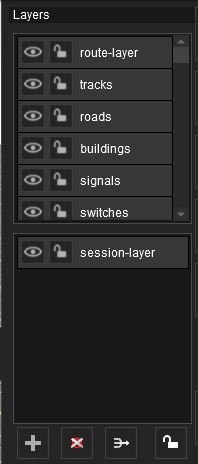Do you have a strategy when it comes to using layers?
Before layers, I would add a Surveyor Only tag to my objects if they were only to be seen in Surveyor and not in Driver. Clumsy but it worked. That still left the problem when objects were placed very close to each other. Trying to select and modify one was often an exercise in frustration.
They they added layers. Now any object can be rendered invisible by placing it on a specific layer and then hiding that layer. Layers and the objects it contains can also be locked so they can't be selected. I often put switches and signals on separate layers so I can work on one without disturbing the other.
Recently I ran into a issue related to layers see this thread. When objects could belong to two separate layers, i.e platforms with attached track, I used to assign the platform to a station layer and the track to a track layer. Somewhere along the way, some of the tracks ended up in the guide layer. The guide layer is normally hidden in Driver and so some of the track was hidden and the AI got totally confused, as was I, trying to figure out why some track was disappearing.
Now I think I will place all such objects on one layer, in this case a track layer even if part of the object is a platform or building.
So now I use these layers:

All of the above in the route part of the layer tab. The only things I put in the session area are those things that belong to one particular session. For example, if the same basic route will be used in two different time periods, they could have buildings and other objects that are specific to one or the other era.The same with trains. A morning session vs an afternoon session, etc.
Before layers, I would add a Surveyor Only tag to my objects if they were only to be seen in Surveyor and not in Driver. Clumsy but it worked. That still left the problem when objects were placed very close to each other. Trying to select and modify one was often an exercise in frustration.
They they added layers. Now any object can be rendered invisible by placing it on a specific layer and then hiding that layer. Layers and the objects it contains can also be locked so they can't be selected. I often put switches and signals on separate layers so I can work on one without disturbing the other.
Recently I ran into a issue related to layers see this thread. When objects could belong to two separate layers, i.e platforms with attached track, I used to assign the platform to a station layer and the track to a track layer. Somewhere along the way, some of the tracks ended up in the guide layer. The guide layer is normally hidden in Driver and so some of the track was hidden and the AI got totally confused, as was I, trying to figure out why some track was disappearing.
Now I think I will place all such objects on one layer, in this case a track layer even if part of the object is a platform or building.
So now I use these layers:
- tracks (all tracks including objects that have attached tracks)
- roads (all roads and road objects except those with attached tracks)
- buildings (all buildings except those with attached tracks)
- signals (all track signals)
- switches (all track switches)
- trees (all vegetation)
- guides (all guides and other objects not meant to be seen in Driver)
- other layers for special cases not covered by the above

All of the above in the route part of the layer tab. The only things I put in the session area are those things that belong to one particular session. For example, if the same basic route will be used in two different time periods, they could have buildings and other objects that are specific to one or the other era.The same with trains. A morning session vs an afternoon session, etc.
